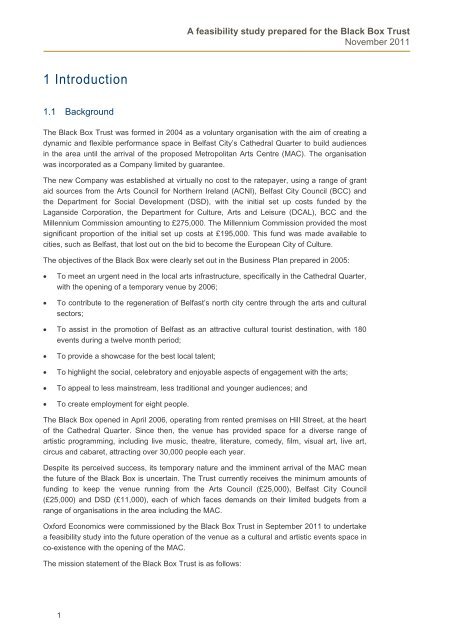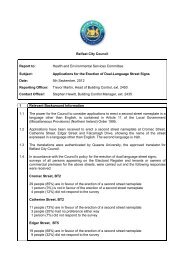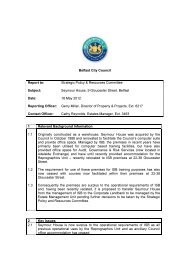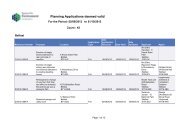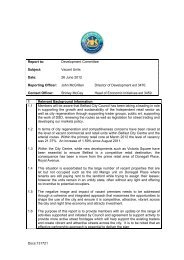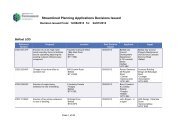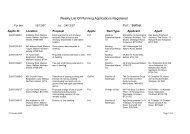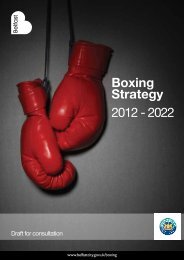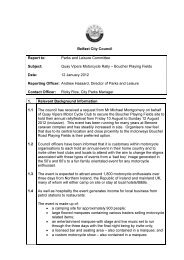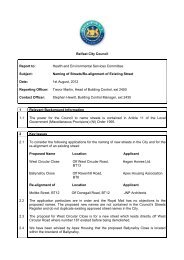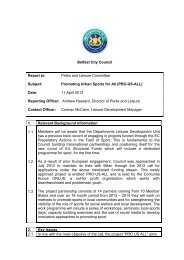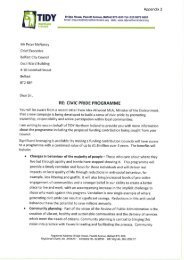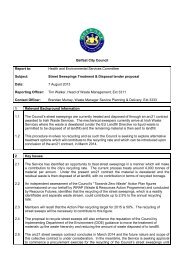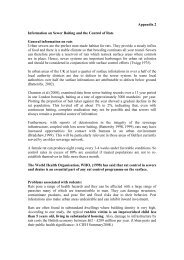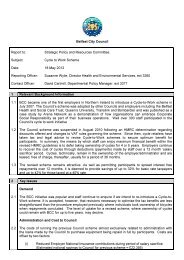FEASIBILITY_STUDY , item 14. PDF 1 MB - Meetings, agendas and ...
FEASIBILITY_STUDY , item 14. PDF 1 MB - Meetings, agendas and ...
FEASIBILITY_STUDY , item 14. PDF 1 MB - Meetings, agendas and ...
- No tags were found...
You also want an ePaper? Increase the reach of your titles
YUMPU automatically turns print PDFs into web optimized ePapers that Google loves.
A feasibility study prepared for the Black Box TrustNovember 20111 Introduction1.1 BackgroundThe Black Box Trust was formed in 2004 as a voluntary organisation with the aim of creating adynamic <strong>and</strong> flexible performance space in Belfast City‟s Cathedral Quarter to build audiencesin the area until the arrival of the proposed Metropolitan Arts Centre (MAC). The organisationwas incorporated as a Company limited by guarantee.The new Company was established at virtually no cost to the ratepayer, using a range of grantaid sources from the Arts Council for Northern Irel<strong>and</strong> (ACNI), Belfast City Council (BCC) <strong>and</strong>the Department for Social Development (DSD), with the initial set up costs funded by theLaganside Corporation, the Department for Culture, Arts <strong>and</strong> Leisure (DCAL), BCC <strong>and</strong> theMillennium Commission amounting to £275,000. The Millennium Commission provided the mostsignificant proportion of the initial set up costs at £195,000. This fund was made available tocities, such as Belfast, that lost out on the bid to become the European City of Culture.The objectives of the Black Box were clearly set out in the Business Plan prepared in 2005:To meet an urgent need in the local arts infrastructure, specifically in the Cathedral Quarter,with the opening of a temporary venue by 2006;To contribute to the regeneration of Belfast‟s north city centre through the arts <strong>and</strong> culturalsectors; To assist in the promotion of Belfast as an attractive cultural tourist destination, with 180events during a twelve month period;To provide a showcase for the best local talent;To highlight the social, celebratory <strong>and</strong> enjoyable aspects of engagement with the arts;To appeal to less mainstream, less traditional <strong>and</strong> younger audiences; <strong>and</strong>To create employment for eight people.The Black Box opened in April 2006, operating from rented premises on Hill Street, at the heartof the Cathedral Quarter. Since then, the venue has provided space for a diverse range ofartistic programming, including live music, theatre, literature, comedy, film, visual art, live art,circus <strong>and</strong> cabaret, attracting over 30,000 people each year.Despite its perceived success, its temporary nature <strong>and</strong> the imminent arrival of the MAC meanthe future of the Black Box is uncertain. The Trust currently receives the minimum amounts offunding to keep the venue running from the Arts Council (£25,000), Belfast City Council(£25,000) <strong>and</strong> DSD (£11,000), each of which faces dem<strong>and</strong>s on their limited budgets from arange of organisations in the area including the MAC.Oxford Economics were commissioned by the Black Box Trust in September 2011 to undertakea feasibility study into the future operation of the venue as a cultural <strong>and</strong> artistic events space inco-existence with the opening of the MAC.The mission statement of the Black Box Trust is as follows:1


